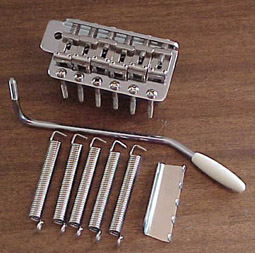Tone is Not A Destination It's a Journey
What really defines good tone? Unfortunately only you can make that call. If we all liked the same thing this would be a pretty boring place. Tone, it's such a subjective thing. But, you have to start somewhere, right? So let's start from where the signal begins and follow the signal all the way to where it ultimately ends, the listener.
Different
Guitars, Different Tone
From
personal experience I've found almost every guitar has its own
personality. Even two guitars made from virtually the same type
of parts will sound different. Why? Body wood is the main factor
here. The uniqueness of wood makes the difference. That's why it's
so important to try several guitars until you find that special
instrument that speaks to you. Try to forget all the hype manufacturers
put in the guitar rags. Learn to trust the most valuable analyzers
God has given you, your ears. For beginners it's often hard because
they have no point of reference . My advice is find a player with
some experience whos tone you like and ask for some guidance. For
a good explanation of how different woods affect your tone go here: http://www.jemsite.com/jem/wood.htm
With so many guitars of every shape and size, how does one go about choosing the right one? Well, first decide what your budget is and then go from there. You'll find two types of pickups. Single coil and humbucker designs. Les Pauls, PRS and even some Fender guitars have humbuckers while Fender Strats and Teles are usually equipped with single coils. What's the difference tone-wise? Single coils are brighter sounding and have a bell-like tone while humbuckers are meatier and darker sounding. Only you can decide which one is best for you. Some humbuckers can be wired so that only one of the two coils is activated at a time. And some single coils use a stacking technique to obtain a hum-free vibe. I personally have a set of Fender Vintage Noiseless pickups in one of my Srats and my Tele. Some like them and some hate them. What's right for you? Only you can make that choice. My advice, go play and decide for yourself.
I would have to say that the pickups and the type of wood a guitars body is made of are two of the most important factors contributing to a guitars tone. The next most contributing factor is the neck. Here again the type of neck wood and construction play a big part in the tone. Most Fenders, except some Fender Custom Shop guitars, have maple necks with either a rosewood slab or plain maple. In my experience, rosewood yields a softer warmer tone than maple. Maple seems to render a sharper attack and slightly brighter tone. My Les Paul has a mahogany neck with a ebony slab fretboard. I find ebony to be similar in tone to rosewood but maybe a little darker and warmer.
Next, tone-wise, I would have to say that the bridge and nut are the next biggest factors in regard to tone. If your guitar comes with a plastic nut you may want to replace it with one made from bone. It won't cost a lot and the benefits, tone-wise, are well worth the cost. A bit of advice, have a competent luthier do the mod. It looks simple enough, but you could ruin a neck fairly easy if you don't know what you're doing. I've seen some guitars that even have nylon or plastic bridge saddles. These do not render good sustain. If staccato attack is what you're after, fine, but if want maximum sustain metal saddles are the ticket. Next time you see a Tele take notice how the bridge pickup is mounted on the metal plate. This is what gives the Tele its uniqueness tone-wise. Most Nashville chicken pickers, such as Brent Mason, get their signature tone from a Tele using the bridge pickup. No guitar sounds quite like a Tele, but a Tele. Some may come close, but there's nothing like the twang a Fender Tele gives you.
Want to make a valuable mod to your Stratocaster? Check out the custom made trem/bridge assembly made by Callaham Guitars: http://www.callahamguitars.com/ This guy has these Vibrato/Tremolo Replacement Blocks and Bridges custom made from vintage specs. He also makes some awesome guitars. Take a look around, I think you'll like what you see. Here's a mp3 made after I installed a complete Trem/Block Bridge Assembly I ordered from Callaham. As they say, the proof is in the pudding.
Frets
I
might as well mention frets here also. Although I don't feel they
have a dramatic affect on your tone I do feel that the medium and
jumbo sizes are the most desirable. Some say the jumbos will give
you more sustain. I honestly don't know if they do or not. I just
know I prefer jumbo fretwire for my playing style. They are easier
to grab when bending and just plain feel better to my hands.
Cabling,
The Most Over-Looked Factor in Tone
If
your tone is only as good as its weakest link then quality cabling/interconnect
is a vital part of your tone equation. Unfortunately, most players
will spend thousands of dollars on their rig and then ruin it with
sub-par cabling. Okay, I use Monster Cables, had them 15 years
and they work as good as the day I made them. You don't have to
use Monster Cabling. They are too expensive for some. George L
or a comparable interconnect will do. The main thing is to not
skimp here, after all, this is what carries your tone from point
A to point B. Don't even think about true-bypass effects pedals
if you're using sorry cabling. I know players that give me a hard
time about my Boss pedals while they are using cabling that's sucking
their tone right out of their rig.
Effects
Pedals and Tone Shaping
Man, one could write a book on this subject. I buy effects pedals like my wife buys shoes. You can never have too many stomp boxes. They defone the character of your tone. Besides your guitar and amp, effects will contribute the most to your signature tone. I currently have thirty two pedals. The order you run your pedals make a big difference in the tone and how each pedal reacts to each other. In my experience it's best to run some effects through the effects loop of your amp. Delay and noise gates should be ran in the effects loop if your amp has one. Other effects like compression and distortion should never be ran into an effects loop. Try it and you'll see why. My old Fender Super Reverbs don't have effects loops. Here is the order I run them:
Dunlop Cry Baby (CMAT Modded)
Boss CS-3 Compressor (Opto Plus Modded)
Boss BD-2 (H2O Plus Modded)
Boss SD-1 (GT Modded)
Boss DS-1 (Rectifer Tri-Gain Plus Modded)
Boss MT-2 (Sustainia Tri-Gain Plus Modded)
Ibanez TS-9 (Tri-Gain Modded)
Boss DD-6 Delay
Boss NS-2 noise gate
Yamaha MagicStomp Version II
Line6 DL4 Delay Modeler
Amplifiers
and Tone
Probably the biggest single contributing factor to your tone will be the amp you choose. The best advice I can give you here is to find an artists tone you like and do some research. Be warned, don't expect to sound like Eric Johnson just because you own a 1954 Strat, two Fender Deluxe Reverbs and a vintage 50 Watt Marshall. Don't get me wrong, that would be a good starting point. But great tone comes from the heart, soul and fingers of the person playing. Equipment, in and of itself, is only part of the equation. The remainder, literally, rests in your hands and fingers.
Solid State or Tube? The debate goes on and on and on and on. I've owned both and, IMO, both have their place. For Blues, R&B, C&W, Jazz or Pop you're probably better off with a tube amp. If metal is your chosen genre, Solid State may be the ticket. But let's not forget the Digital Modeling amps. I bought a Line6 Flextone a couple of years back and if variety is important to you as a player, these are worth a look, although I eventually sold it and bought a Fender Cyber Deluxe which, BTW, I still own it 4 years later. I also once owned a POD and for some things they really work well, but I sold it, it was just not my bag. My biggest gripe with most of the modeling technology is their lack of dynamics. They seem to do one thing really well and a lot of things not so well. As the technology progresses and the bit and resolution rates increase from 16 to 24 and above, I think you'll even see some die-hard tube snobs taking a closer look at this technology. It's certainly worth keeping an eye on.
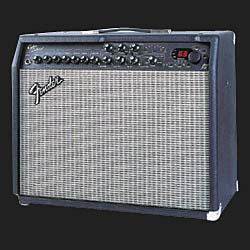
Fender
Cyber Deluxe Combo
I purchased this amp in May of 2003. After gigging with it I am very impressed with what this amp offers tonewise. The Cyber Deluxe does not suffer the shortcomings of other modeling amps. The cleans are vintage Fender all the way and the overdrive models are as good as they come on a modeling amp. Very dynamic and responsive. Not a tube in it and you won't care. The tone is that good. I recorded a few sound bites below that I feel demonstrate the strengths of the amp.
BTW, the guitar used on these mp3s was retrofitted with my tuning system, the eNut™.
Click here to read more about this system that will break the price barrier at less than $25. Notice how the samples are very in tune all the way up and down the neck. This system beats every system being offered today and will break the price barrier at under $25.
Clean_1.mp3 Clean_2.mp3 Clean_3.mp3 Clean_4.mp3 Clean_5.mp3 Clean_6.mp3 Clean_7.mp3 Model_Examples.mp3 Overdrive_1.mp3 Overdrive_2.mp3 Overdrive_3.mp3 Overdrive_4.mp3 Overdrive_5.mp3
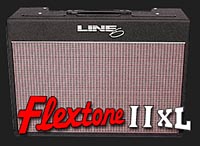
Line6
Flextone II XL
I
purchased a Flextone II XL because of its ease of setup and versatility
when traveling and gigging on the road. But, after a few months
sold it and bought a Fender Cyber Deluxe. I've made some mp3s below
that I have created using the SoundDiver app. Since I've only had
it a few days I haven't had a lot of time to experiment. I still
haven't found a usable clean and crunch setting but the saturated
and distortion tones sound pretty good so far. I'll be adding some
patches from the SoundDiver utility once I get enough to offer.
Here are the mp3s.
Flex1.mp3 Flex2.mp3 Flex3.mp3 Flex4.mp3 Flex5.mp3 Flex6.mp3
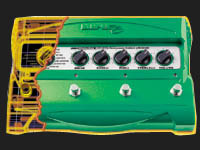
Line6
DL4 Delay Modeler
Anyone
that knows me knows that delay is a big part of my music. The DL4
is absolutely the best bang for the buck in delay effects on the
market.
The
DL4 Delay Modeler offers you an incredible array of sounds, from
a tube driven, tape loop echo (complete with adjustable wow and
flutter), through 24 bit squeaky clean digital echo, to real-time
reverse delay. Incredibly simple to use, it's an amazingly powerful
tool offering you delay effects never before available in a single
box.
The DL4 offers: Digital modeling based on 15 of those vintage delay and echo
effects you've always yearned for. Including: EP-1 Tube Echoplex, EP-3
solid state Echoplex, Space Echo, Deluxe Memory Man, Reverse delay ,
Rhythmic delay, Dynamic delay and many more!
Includes 14 seconds of memory + 800ms of Pre-delay (sort of a delay within
a delay), and features half speed and/or reverse overdubbing.
Line6
DL4 Delay Modeler MP3 Samples
Samples
were played on a Custom Built Tele with a set of Joe Barden Tele
Pickups. The signal path was Tele-> Boss CS-3-> Ibanez TS7-> Line6
DL4-> 1975 Fender Super Reverb-> Shure SM57-> FMR Audio
RNC Compressor-> Avalon U5 Preamp-> Apogee AD500E Analog
to Digital Converters-> Roland VS880-> Macintosh G3/500-> Cubase
VST-> Bias Peak-> MP3.
DL4_Auto_Volume_Delay.mp3
DL4_Delay_Mod.mp3
DL4_Delay_Mod_TS7.mp3
ZOOM
PD-01 OverDrive Pedal
Samples
were played on a Custom Built Strat with a set of Fender Vintage
Noiseless Pickups. The signal path was Strat-> Boss CS-3-> ZOOM
PD-01-> 1975 Fender Super Reverb-> Shure SM57-> Avalon
U5 Preamp-> Apogee AD500E Analog to Digital Converters-> Roland
VS880-> Macintosh G3/500-> Cubase VST-> Bias Peak-> MP3.
Zoom
PD-01.mp3

Boss
CS-3 Compressor
I
know, it's not true-bypass and the effects snobs hate these pedals.
But somehow players like Brent Mason and other pros don't seem
to mind.
I love the rubbery, smooth, over-the-top vibe of this compressor. I set the knobs just like the pic, straight up. It's a little noisy if overused but this pedal rocks. Great for all styles. And when modded with my Opto Plus kit the noise is reduced and transparency increased. With the Opto Plus mod this compressor sound as good as compressors selling for 4X the cost of a modded CS-3.
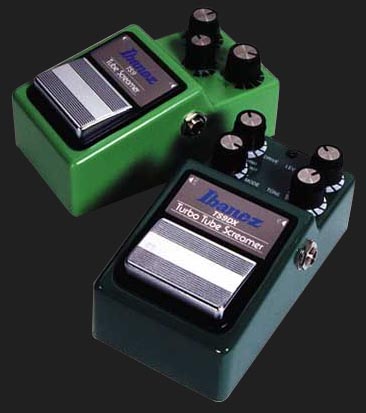
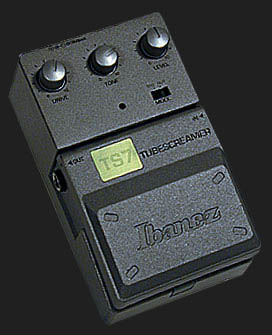
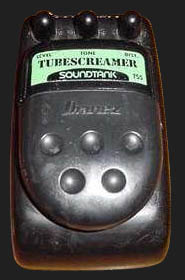
Ibanez TubeScreamer
Possibly
the best and most famous overdrive of all time. I own several models
of this pedal and love each one. Even the bug shaped TS5 with it's
plastic enclosure has great tone. Especially if you put one of the
JRC4558D opamp chips in it and replace a couple of resistors.
Do yourself a favor and mod these pedals with one of the mod kits I sell. The kits completely transform these pedals into boutique killers.

Boss NS-2 Noise Suppressor
I use
one of these as the last device in my live rig. It also has the capability
of driving several other pedals when used with an AC Adapter and
one of the Boss daisy chain strings. Also features an effect send
and return which I use to drive a Boss Tuner. Adjustable release
and decay and also has a mute switch.

Dunlop Crybaby
From Jimi
Hendrix to Eric Clapton, you'll find a Crybaby splashed on decades
of music. A must have for every guitarists effects arsenal.
